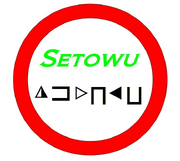
Setowu logo
Overview[]
This conlang project is the result of a couple years of work (in what spare time I have), to produce a language which works according to a "radical" logic (that is, it combines short words or concepts, called "radicals", into longer compound words, much as is done in Chinese). The language of Sona was an inspiration in this regard.
Another idea was to use well-known already assembled lists of "basic" or "index" words to serve as the "radicals" for the language. The basic idea behind the language is to provide a small vocabulary made up of lists of words drawn from Charles Kay Ogden's Basic English and headwords from the Roget II thesaurus as well as a set of grammatical particles and a short set of rules for making compound words and sentences.
A final objective was to select the dictionary entries for the language using purely random word assembly methods (in order to avoid any "Eurocentric" sound to the language). A spreadsheet program was used to randomly assign phonemes to radicals for the language.
Now that the language has more or less been "completed", it is essentially in its "Beta" phase - what is needed is for people to test-drive the tools for the language that have been provided, to see if it is possible to express the ideas people want to express using these tools.
Setting[]
See the Setowu page for more details. Participation in the construction of this wiki is most welcome.
Basic Grammar[]
The Rules of Setowu grammar involve only a few basic principles of sentence construction.
Dictionary[]
The overall Setowu dictionary contains 1161 words. Other words can be formed by making compound words via the use of a hyphen.
Script[]
Setowu has its own script, which uses Unicode characters.
Example text[]
Here is the translation for "My hovercraft is full of eels."
Come give it a try![]
Want to say something in "conversational Setowu"? Try out the "Public Chat" page !
